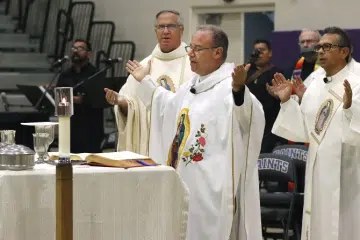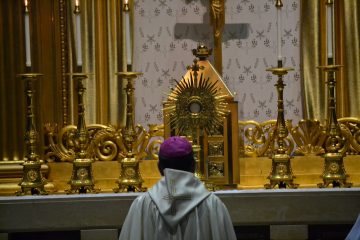The Roman Missal: the church’s common treasure
January 6, 2011
By Lynn Williams
ARCHDIOCESE — The Roman Missal, Third Edition, the ritual text containing prayers and instructions for the celebration of the Mass, has been approved by the Congregation for Divine Worship and the Discipline of the Sacraments. First use of the new text of the new Roman Missal will be on the First Sunday of Advent, Nov. 27.
 |
Pope John Paul II announced a revised version of the Missale Romanum during the Jubilee Year 2000. Among other things, the revised edition of the Roman Missal contains prayers for the observances of recently canonized saints, additional prefaces for the Eucharistic Prayers, additional votive masses and masses and prayers for various needs and intentions, and some updated and revised rubrics (instructions) for the celebration of the Mass. The English translation of the Roman Missal will also include updated translations of existing prayers, including some of the well-known responses and acclamations of the people.
In the Archdiocese of Cincinnati, the Worship Office has been working with priests and parish leaders to prepare for the implementation. While the majority of education about the new Roman Missal will take place on the parish level, the United States Conference of Catholic Bishops has made available to diocesan newspapers a series of informational articles about this change. We will publish these on a regular basis throughout the year to help readers become more familiar with the changes, their history and the reason for them.
The new English translation of the Roman Missal, the official manual for the Roman Catholic Mass, has been approved, and soon familiar prayers and responses said in churches around the English-speaking world will change. Priests will follow newly translated instructions. Prayers used throughout the Mass and some responses of the congregation will change. Sacred chants and music used in worship will also be updated.
The full texts of the English translation received recognitio, or approval, from the Vatican in June and July of 2010. The new translation will be implemented in U.S. dioceses in Advent 2011. It will be the most significant change to the Mass in over 40 years.
An occasion like this raises the question: Why is the Roman Missal so important?
“The Roman Missal is a common treasure,” says Msgr. Anthony Sherman, executive director at USCCB Secretariat of Divine Worship. “It is the book that provides us with prayer text. It serves as a point of unity that keeps us all together, presenting the prayers that are used around the world, in many languages, during universal feasts or holy days.”
Latin is the core text of the Roman Missal, evolving from oral tradition to written words. During the 15th century, in the era of the first printing press, the earliest book called Missale Romanum appeared. After the Council of Trent in 1570, Pope Pius V issued the edition that set the premier standard of uniformity used by celebrants of the Catholic faith.
Eight former popes issued new editions between 1604 and 2002, and each maintained a consistent style of worship for prayer in the Roman rite. Over time, additional masses, prayers and revised rubrics (instructions) used to celebrate the Mass were added. The need for vernacular translations of the Roman Missal arose after the Second Vatican Council, and the present English translation of the Mass, which dates back to the 1970s, follows the Vatican’s guidelines of that time, which favored translations that were easy to understand in the vernacular.
| Additional Resources |
|
If you are interested in seeing the new Order of the Mass, the U.S. Conference of Catholic Bishops has it online at http://www.usccb.org/romanmissal for educational/catechetical purposes. The Worship Office of the Archdiocese of Cincinnati is sponsoring Lex Orandi, Lex Credendi, Lex Vivendi: Making connections in the liturgy, a series for persons of all ages, Jan. 10, 17, 24, 31; Feb. 7, 7-8:45 p.m., St. Aloysius Gonzaga Parish, 4266 Bridgetown Rd., Cincinnati. $25 per person; $200 parish registration. Information: 513-421-3131, ext. 6609. In Dayton, the program will be offered April 26, May 3, 10, 17 and 24 at St. Charles Borromeo Church in Kettering. More information will be available on the website of the Worship Office at: www.catholiccincinnati.org and in The Catholic Telegraph. |
When Pope John Paul II issued the Third Edition of the Roman Missal in 2002, a new English translation was required. Since the new English translation is guided by the 2001 Vatican document Liturgiam Authenticam, it presents a more literal translation of Latin wording and sentence structure than is used in the current translation.
“The current translations are centered more on the community than the divine,” says Father Paul Turner, a pastor in the Diocese of Kansas City-St. Joseph, Missouri and author of Let Us Pray: A Guide to the Rubrics of Sunday Mass. “They were somewhat inattentive to inclusive language, and lacked some theological depth and musicality. The first translations condensed some of the content of the prayers. The new translation improves that,” he says.
“This is not a new mass,” says Michael McMahon, president of the National Association of Pastoral Musicians, adding that with a new translation, “one of the opportunities we have is to look at the parts of the Mass that should be sung” in the dialogue between the priest and the people and integrate them. One of the challenges of introducing a newly translated missal is retraining priests to lead mass. Downloadable recordings for priests who don’t read music are being produced and distributed free, online. Major publishers will release material on compact discs.
The Roman Missal itself is the primary source of training and instruction for the new translation. It displays rubrics, sentences printed in red that instruct a priest on what to say and do, how and when to gesture, and when to sing the common prayers in the Order of Mass. It provides instructions that guide the celebrant in leading the liturgy and the people assembled in ritual response for each occasion of mass.
It also dictates the words used by a priest during the Mass, which with the new translation will reflect a more formal style than past translations.
“It will sound much more like Latin,” says Father Turner.
“The Roman Missal puts us into a tradition of prayer and creates an historical awareness in the roots of where we are now,” says Msgr. Sherman. “When you study the background of these prayers, you become united” with the perpetual mission of the church.
Lynn Williams is a full-time communications consultant and an award-winning freelance journalist from Nashville, TN. She is a frequent contributor to the Catholic press.











